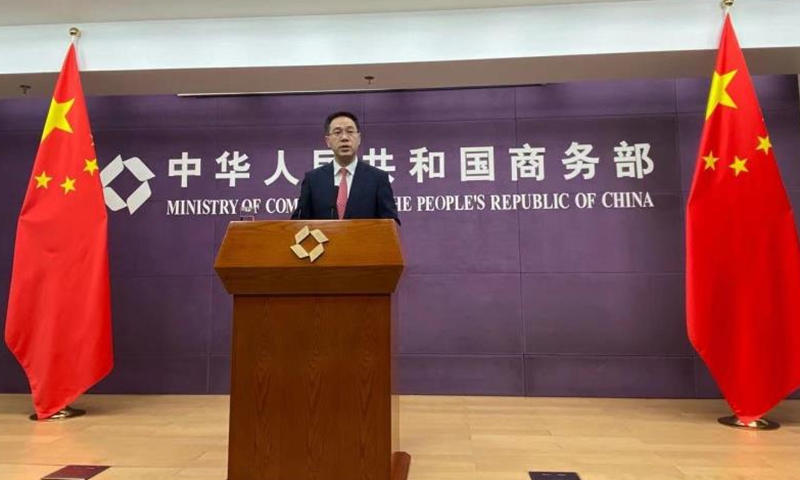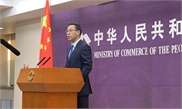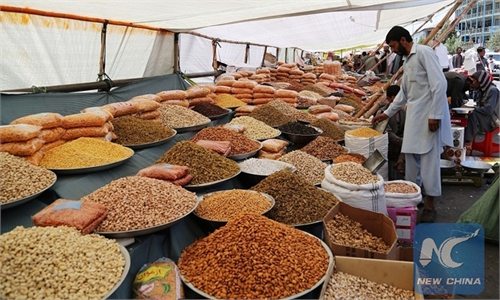
Gao Feng, spokesperson for China's Ministry of Commerce, at a press conference in Beijing on Thursday Photo: Li Qiaoyi/GT
The trade teams of China and the US have maintained normal communication, China's Ministry of Commerce (MOFCOM) said on Thursday, while urging joint efforts to expand bilateral trade cooperation and promote implementation of the hard-won phase one trade deal between the world's two largest economies.
Data from MOFCOM showed that in the first seven months of 2021, bilateral merchandise trade between China and the US increased 40 percent year-on-year. China's imports from the US increased 50.4 percent, while exports to the US were up 36.9 percent.
The figures indicate that the two economies are highly complementary, and that bilateral economic and trade cooperation is in the interests of both countries and their peoples, Gao Feng, a spokesperson for the MOFCOM, told a press conference on Thursday.
"We have been emphasizing that expanding bilateral trade requires joint efforts, to create the atmosphere and conditions to promote the implementation of the phase-one trade deal," Gao Feng responded when asked by reporters about the status of the deal, which was signed in January 2020.
Despite fraught bilateral relations, trade between China and the US has been moving forward steadily, and China is accelerating the implementation of the phase one trade agreement, in which agricultural trade is the mainstay, experts said.
At the US Soy Global Trade Exchange & Specialty Grains Conference held by the US Soybean Export Council from Tuesday to Thursday, one important topic under discussion was China's rising role in US soybean exports.
In an online forum hosted by the US Soybean Export Council, US experts are optimistic about the implementation of the phase one trade deal.
"I think during the first part of the trade war, both sides were trying to put extra taxes or tariffs on everything, and I think that will sort of move pass that. There are still political tensions, but the policy-makers are getting more targeted about what they are worried about, more on things like technology and cybersecurity," said Darin Friedrichs, senior Asia commodity analyst of StoneX.
As the world's largest soybean importer, China has become the most important market for global soybean exporters, especially the US, the world's largest soybean producer.
China's grain imports from January to July stood at 91.7 million tons, a year-on-year increase of 37.2 percent. Of the total, soybeans accounted for 58 percent and corn for 18.3 percent.
Under normal trade conditions, 30-40 percent of China's soybean imports and 15 percent of corn imports come from the US, media reports said.
In a previous interview with the Global Times, Jim Sutter, CEO of the US Soybean Export Council, said that "we are at a record level for 2021 new US soybean crop shipment positions starting September 1 onwards, with China having purchased 2.6 million tons of US soybeans as of April 1."
Sutter expected about 36 million tons of high-quality, US soybeans will be exported to meet China's domestic needs in the 2020/21 marketing year, which runs from September to August.
Zhang Xiaoping, regional director for the greater China region, US Soybean Export Council, said during the forum that business relations between China and the US -- especially soybean trade -- should be stronger, and the council wants to act as a bridge toward such improved relations.
"What we are working for is also to keep the trade going," said Zhang.
While China is pushing its efforts to implement the phase-one trade deal, US businesses can no longer stay in the corner and wait for US President Joe Biden's trade team to act. The US-China Business Council wrote a letter from some of the US' largest business associations including the US Chamber of Commerce earlier this month, urging the Biden administration to step up efforts at working with the Chinese government to increase purchases of US goods through the remainder of 2021 and take swift action to address the costly and burdensome tariffs and retaliatory tariffs.
"The US tariffs are not good for either country, nor for the recovery of the world's economy," Gao Feng stressed on Thursday.
In response to the letter, US Trade Representative (USTR) Katherine Tai said the Biden administration and USTR are conducting a comprehensive review of US-China trade policy, US media reported. Seven months after Biden took office, his administration has yet to establish a trade policy with China.
The phase one trade deal was signed by a Republican president, and the Biden said on August, 2020 that 'he would remove Donald Trump's tariffs on imports from China, which are taxes on US consumers and companies,' but even the review of the trade agreement has not been completed, Gao Lingyun, a trade expert at the Chinese Academy of Social Sciences in Beijing, told the Global Times on Thursday.
"We could complete the deal, because these things are what China needs, especially agricultural products. The reason why the current progress is not enough is essentially the impact of the epidemic, which has caused shipping to be blocked," said Gao Lingyun.
He predicted that the China-US trade in the second half of the year may be better than the first half, "because the second half is traditionally the peak season for bilateral trade due to surging demand, driven by the Christmas holiday."
But this year may be a little unusual. The performance will still be good but not as good as last year, because the US economy is recovering as vaccines are more widely distributed, US productivity is recovering, and there will be partial substitutions for Chinese products, according to Gao Lingyun.



